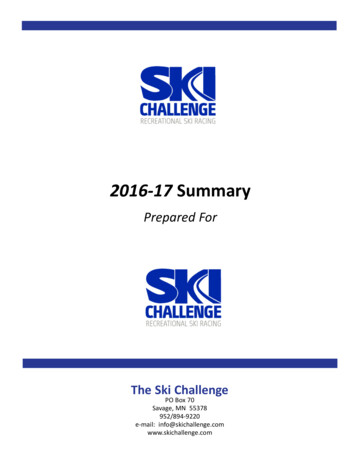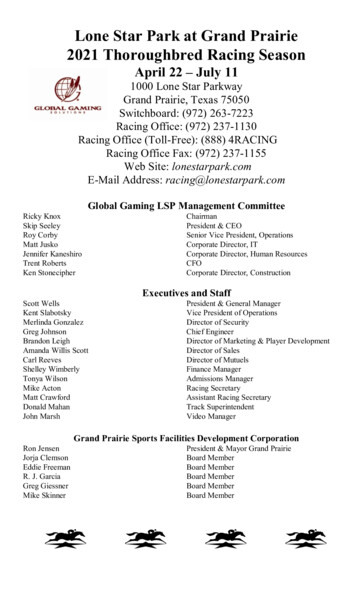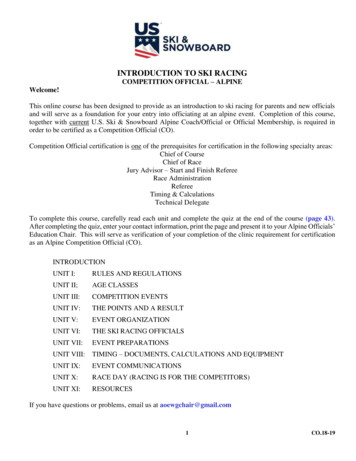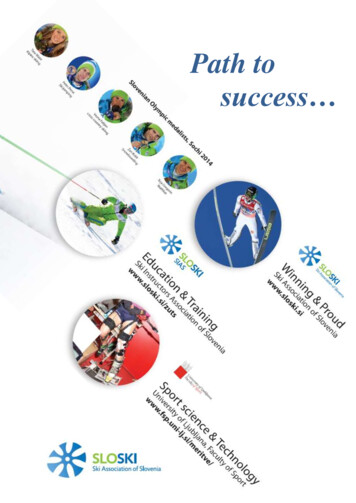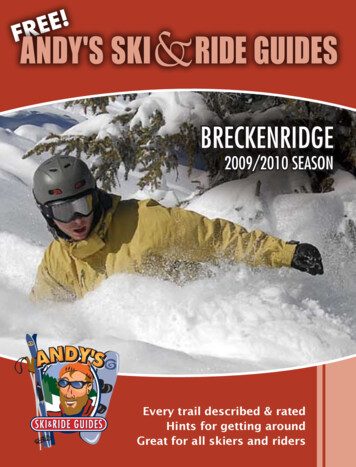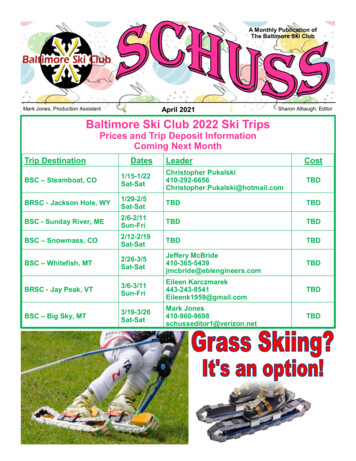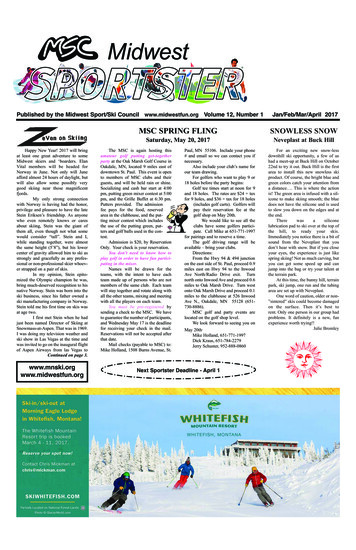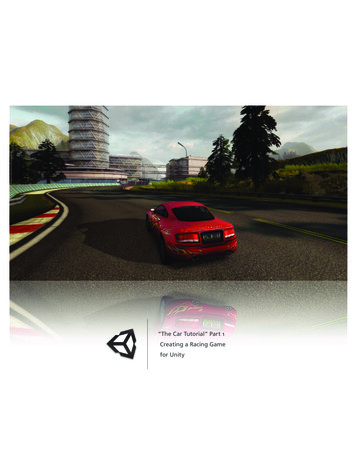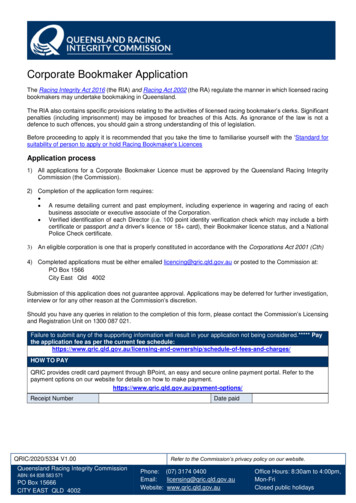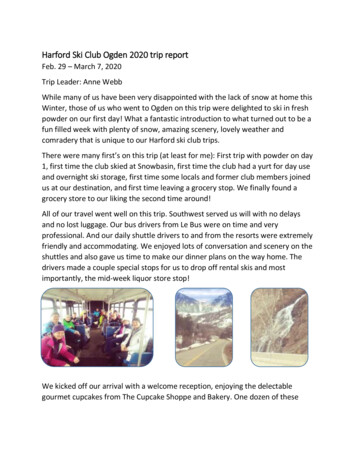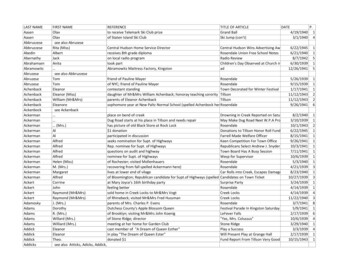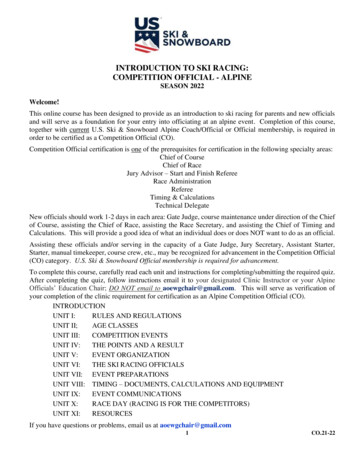
Transcription
INTRODUCTION TO SKI RACING:COMPETITION OFFICIAL - ALPINESEASON 2022Welcome!This online course has been designed to provide as an introduction to ski racing for parents and new officialsand will serve as a foundation for your entry into officiating at an alpine event. Completion of this course,together with current U.S. Ski & Snowboard Alpine Coach/Official or Official membership, is required inorder to be certified as a Competition Official (CO).Competition Official certification is one of the prerequisites for certification in the following specialty areas:Chief of CourseChief of RaceJury Advisor – Start and Finish RefereeRace AdministrationRefereeTiming & CalculationsTechnical DelegateNew officials should work 1-2 days in each area: Gate Judge, course maintenance under direction of the Chiefof Course, assisting the Chief of Race, assisting the Race Secretary, and assisting the Chief of Timing andCalculations. This will provide a good idea of what an individual does or does NOT want to do as an official.Assisting these officials and/or serving in the capacity of a Gate Judge, Jury Secretary, Assistant Starter,Starter, manual timekeeper, course crew, etc., may be recognized for advancement in the Competition Official(CO) category. U.S. Ski & Snowboard Official membership is required for advancement.To complete this course, carefully read each unit and instructions for completing/submitting the required quiz.After completing the quiz, follow instructions email it to your designated Clinic Instructor or your AlpineOfficials’ Education Chair; DO NOT email to aoewgchair@gmail.com. This will serve as verification ofyour completion of the clinic requirement for certification as an Alpine Competition Official (CO).INTRODUCTIONUNIT I:RULES AND REGULATIONSUNIT II;AGE CLASSESUNIT III:COMPETITION EVENTSUNIT IV:THE POINTS AND A RESULTUNIT V:EVENT ORGANIZATIONUNIT VI:THE SKI RACING OFFICIALSUNIT VII: EVENT PREPARATIONSUNIT VIII: TIMING – DOCUMENTS, CALCULATIONS AND EQUIPMENTUNIT IX:EVENT COMMUNICATIONSUNIT X:RACE DAY (RACING IS FOR THE COMPETITORS)UNIT XI:RESOURCESIf you have questions or problems, email us at aoewgchair@gmail.com1CO.21-22
U.S. SKI & SNOWBOARDINTRODUCTION TO SKI RACING:COMPETITION OFFICIAL - ALPINESEASON 2022INTRODUCTIONPLEASE NOTE: Local health authority restrictions may require ski area management to implementprocedures to protect the well-being of their employees and guests. These procedures may vary fromvenue to venue, county to county, and state to state. Procedures which impact your event operationsand programs must be relayed to all event officials, Team Captains, and competitors. The proceduresmust – without question – be respected and observed.U.S. Ski & Snowboard will continue to maintain a COVID-19 resource page with recommendedprotocols (usskiandsnowboard.org/covid-19).There are numerous jobs available for parents and volunteers. Some require better skiing skills, but many canbe performed by anyone regardless of their level of skiing ability – even non-skiers may apply!This course will contain many references to specific documents/forms which are part of the “Master Packet ofForms” (MPF) which is located on the U.S. Ski & Snowboard website. The following documents providereferences to terminology used throughout this course and can be found at the end of this presentation (pages31-42). Print and keep them handy for reference as you proceed.Document numbering is not sequential because it agrees with document numbering in the current “MasterPacket of Forms” (MPF).Abbreviations and Terminology34. Report by the Referee30. Start/Finish Timekeeper Recording Form60. & 61. “Fault Only” Gate Judge Card (Gate Keeper) and Instructions*62. & 63. “Fault/No Fault” Gate Judge Card (Gate Keeper) and Instructions*70. Alpine Official’s Personal Activity Record71. Alpine Official’s Recommendation Form20. Volunteer Competition Worker Registration FormI.RULES AND REGULATIONSIt is the responsibility of every official and competitor to know, understand, and abide by the rules forthe sport. One of the questions most often asked by people new to the world of ski racing is, “Wheredo all these rules come from?” In overview form, this is an outline of the various sources of rules andguidelines.International Rules – FIS International Rules of Competition (ICR):The Federation Internationale de Ski, known as FIS (pronounced “fiss”), is the world governing bodyof ski racing. It establishes the standards to which all national governing bodies must conform.The International Ski Competition Rules, also known as the ICR, is published by the FIS Office;“Precisions,” (updates) if required, are published prior to the start of the competition season. Updatedpublications are posted on the FIS website at fis-ski.com and are also available through a link on theU.S. Ski & Snowboard website. The FIS Office is the only valid source for official rules governing aFIS event.2CO.21-22
The ICR forms the basis for all alpine ski competitions sanctioned by a national governing body.“Precisions” are published twice a season; once in early summer for the Southern Hemisphere andagain in the fall for the Northern Hemisphere.FIS also publishes other rule books which address specific topics and particular requirements fordifferent levels of competition. These include, but are not limited to, FIS Timing Booklet, Rules of theFIS Points, Rules for the Alpine FIS Continental Cups, Rules for the Alpine FIS Ski World Cup, andSpecifications for Competition Equipment. These rule books are updated every season; if additionalupdates are required, they are published in the “Precisions.”U.S. Ski & Snowboard Rules:U.S. Ski & Snowboard is the national governing body (NGB) for the sports of skiing and snowboardingin the United States. It establishes the standards to which all Regions/Divisions must conform.U.S. Ski & Snowboard, in conjunction with the United States Olympic Committee (USOC) and theInternational Olympic Committee (IOC), sponsors the U.S. Ski Team, as well as any World Cup, WorldChampionship, and Olympic competitions held in this country.U.S. Ski & Snowboard publishes its alpine rules and regulations as the U.S. Ski & Snowboard AlpineCompetition Regulations or ACR. * [These rules and regulations are not applicable at FIS events.] Thenumbering of the ACR mirrors, when possible, ICR rule numbering, and U.S. Ski & Snowboardexceptions to these rules are identified with a “U” preceding the rule number; the “U” is a part of theU.S. Ski & Snowboard rule number. *The FIS International Competition Regulations (ICR) andadjuncts shall govern any and all issues not addressed therein.Region/Division Rules:Each Region/Division may also publish rules for competitions held in their respective areas. Theserules are limited in scope, govern eligibility requirements, and may also amend certain restrictionswithin age classes. Region/Division rules are published annually in a handbook and may also be foundon U.S. Ski & Snowboard Region/Division websites.,Local Rules:Local rules are published in the material distributed for individual events; this material is often referredto as the event “Race Announcement,” “Fact Sheet,” or “daily Program.” These rules govern suchmatters as the local ski area rules and regulations, restrictions for lift access, deposits required for racingbibs, and other issues related to a specific event.II.THE AGE CLASSESSki racing is structured to provide a progression of basic skills and racing ability through the course ofa competitor’s career. Competition is a necessary element of all ski racing; however, results are notemphasized at the younger age levels. The youngest athletes are nurtured and reaffirmed; fun andpersonal improvement are emphasized over results.Athletes are taught the fundamentals and basic skill required for ski racing. As they mature, advancedskills are introduced as is developmentally appropriate, and they are exposed to more intense levels ofcompetition where their skills are challenged to greater degrees.A competitor’s age class is determined by their age on December 31 of the current competition season.The current competition season is Season 2022, so a competitor’s age class is determined by actualage on December 31, 2021.3CO.21-22
Instructional Level – U12:U12 athletes are 11 years of age and younger. Although only one membership category is publishedfor this age group, Organizing Committees organize events to allow for U10 (under 10) and possiblyU8 (under 8), recognition. If the three age groups are competing, remember U8’s are governed by U10course setting specifications, so U12 course setting specifications would apply (1 class higher).This first level establishes a forum for teaching fundamentals and basic racing skills and for havingfun.These younger athletes compete at an instructional level. Racecourses are basic and are set to test arange of fundamental skills. There is an emphasis on fun and improvement of fundamental skiing andracing skills.Competitors at this level may not be allowed to employ specialized equipment. For example, use ofspeed suits and ski wax may be limited or discouraged, and only one pair of skis may be allowed peran event’s course inspection(s) and competition.U14 Competitive Level:U14 (under 14), athletes are 12 and 13 years of age.This is the first competitive level in which all event types are explored. Racecourses follow the U.S.Ski & Snowboard specifications. Events at this level are timed, and some Regions/Divisions allowthese events to be scored to the National Points System (NPS).Results are recognized with trophies and/or medals in the same manner as in upper-level races. Theemphasis is on fun and improvement through the use of advanced skills.U16 & over Competitive Level:U16 and over are athletes 14 and 15 years of age and older; and Senior athletes are 21 years of age andolder.U16 is the first competitive level where all races are scored, and competitors can earn points by whichthey are ranked at the national (U.S. Ski & Snowboard) level.Athletes 16 years of age and older as of December 31 of the current competition season can earn suchseeding points at the national (U.S. Ski & Snowboard) level and, if they chose to register as a FISathlete, at the international (FIS) levels. At these levels, seed points are used to rank competitors forfirst-run start orders. Racecourses follow the U.S. Ski & Snowboard and, when applicable, the FISspecifications and are set according to the level of competition as well as the ability of the field.The emphasis is on advancing multi-event racing skills and preparing athletes for competing in upperlevel events.Other U.S. Ski & Snowboard Racing Opportunities:Collegiate Ski Competition:Collegiate ski competition is an important part of the sport in the United States as it provides postsecondary school age competitors the opportunity to continue their ambitions in ski racing whilepursuing goals in education. College athletes who are U.S. Ski & Snowboard competitor members haveaccess to the U.S. Ski & Snowboard National Points List. Many college meets are scored for U.S. Ski& Snowboard points while some meets are organized as FIS-University events where FIS points andinternational rankings may be achieved.4CO.21-22
There are two national collegiate programs: The National Collegiate Athletic Association (NCAA),and the U.S. Collegiate Ski and Snowboard Association (USCSA). Both programs are activelyinvolved with the policy-making process of U.S. Ski & Snowboard through the U.S. Ski & SnowboardAlpine Collegiate Working Group.NCAA varsity team regional college circuits in the East (EISA-Eastern Intercollegiate Ski Association)and in the Rockies (RMISA-Rocky Mountain Intercollegiate Ski Association) offer access to theNCAA Skiing Championships.USCSA offers programs from full varsity teams to club sport teams. Organized into severalconferences, the USCSA provides opportunities for athletes to qualify to one of the six regionalchampionships leading to the USCSA Championships. Both championship series boast elite levels ofcompetition and provide national recognition for their respective programs.In addition to collegiate leagues, many high school athletic associations have successful high schoolleagues that promote snow sport.U.S. Ski & Snowboard’s “Non-Scored Athlete membership” is designed for athletes 14-24 years ofage, as of December 31 of the current competition season. This membership is primarily intended forinterscholastic and intercollegiate racing; it also provides access to all levels of U.S. Ski & Snowboardscored and non-scored events. However, as the name implies, it does not include access to the U.S. Ski& Snowboard National Points List (NPL).Adaptive Ski Racing – Adaptive Competition:Adaptive skiing started in pre-World War II Europe and involves athletes with mobility impairments,amputees, paraplegics, and visual impairments.Adaptive skiing began as a rehabilitation/recreation program and evolved into well-organized nationaland international competitions. Elite-level competitions exist both nationally and internationally up tothe IPC World Cup and Paralympic levels.Adaptive skiing has a three division, multi-class system for determining medals/awards, based onfactored time on course. Classifications are based on physical impairment and type of equipmentrequired by the impairment. Competitors are seeded according to classification and earned seed points.In order to encourage adaptive athlete participation in able-bodied U.S. Ski & Snowboard-sanctionedcompetition, U.S. Ski & Snowboard has adopted a special seeding rule for adaptive competitors. The“Golden Rule” was proposed by Adaptive World Champion, the late Diana Golden, and authorizesspecial start order(s) as outlined in the current Alpine Competition Guide for adaptive athletescompeting in U.S. Ski & Snowboard-sanctioned able-bodied competitions. Except for the specificapplication of the “Golden Rule”, adaptive competitors participating in able-bodied races do soaccording to the rules, procedures, and scoring of those events. (“Golden Rule” seeding may not beused at FIS events.)Recreational Adult Racing – Masters:Masters level racing is recreational racing for adults, 18 and older. The events are organized and scoredaccording to prescribed rules.Racecourses follow the U.S. Ski & Snowboard and FIS specifications, as modified by the MastersGroup and are set competitively. Races are timed and scored according to division rules, and results5CO.21-22
are recognized. The Masters events emphasize social camaraderie, improvement of skiing and racingskills, and the challenge of competition.III.THE EVENTS – Slalom, Giant Slalom, Downhill, Super G, Alpine Combined, Parallel, Kombi,and SkillsQuest:(Disciplines are branches of a sport and may comprise one or several events. For example, Alpine,Cross Country, Freestyle, and Snowboard are disciplines of snow sport, and the following are eventsin the Alpine Skiing discipline.)Slalom (SL) is a technical event requiring the execution of many short, quick turns. The course ismade up of various gate combinations designed to test a competitor’s skill and strategy. Slalom isstaged in two runs, and when possible, should be held on the same day with times added together todetermine final finish order. Slalom for youth (non-scored) may be conducted in either one or two runs.Giant Slalom (GS), is also a technical event and requires competitors to race down the mountainthrough a faster and more open course than slalom. Giant Slalom is staged in two runs that, wheneverpossible, should be held on the same day with times added together to determine final finish order.Giant Slalom for youth (non-scored) may be conducted in either one or two runs. Depending on theterrain and the course set, the Jury may designate “yellow flag zones” in order to stop on-coursecompetitors who are approaching a “start stop” situation.Downhill (DH) is a speed event characterized by a course that tends to follow the contours of the hillor trail and allows the competitors some freedom to find the fastest “line.” Downhill is generally aone-run event; however, in cases where required vertical drop is not possible or the winner’s time isnot equal to a minimum winning time prescribed in the U.S. Ski & Snowboard Alpine CompetitionRegulations (ACR), a downhill in two runs (Sprint Downhill), may be staged.Downhill is restricted to Senior, U21, U18, U16, and U14 competitors; however, U14 competitors maycompete in Downhill events that adhere to special rules. All Downhill courses have “yellow flagzones.” These are areas designated by the Jury for stopping on-course competitors who areapproaching a “start stop” situation. All events require that movement on course be limited. Downhillrequires that, with the exception of the racer on course, there be NO movement. This is commonlycalled a “course freeze”; the course freeze time is noted on the daily Program by indicating whencoaches must be in place.Super Giant Slalom (SG), is a hybrid of downhill and giant slalom. Super G is always a one-run eventand is restricted to Senior, U21, U18, U16, U14, and U12 competitors. U14 and U12 competitors mayonly compete in Super G events that adhere to special rules. U.S. Ski & Snowboard rules do not allowSuper G for younger age groups. Super G courses also have “yellow flag zones”; these are areasdesignated by the Jury for stopping on-course competitors who are approaching a “start stop” situation.All events require that movement on course be limited. Super G requires that, with the exception ofthe racer on course, there be NO movement. This is commonly called a “course freeze”; the coursefreeze time is noted on the daily Program by indicating when coaches must be in place.Alpine Combined (AC) is a two-run event composed of a speed event – either one run of Downhill orSuper G and a technical event – one run of Slalom. The speed portion is usually staged first, but rulesare in place which allow for staging the Slalom first. Rules for the individual events, combined withrules for two-run races, are in effect. Alpine Combined events are currently not being staged for youth.Parallel (P) events are competitions where two competitors race simultaneously side by side down oneof two separate but equal courses. Results are based on either a one-run format or a two-run combined6CO.21-22
time format. If the two-run combined time format is used, the racers switch courses for their secondrun. Overall winner is decided either by fastest time on course (1- run format) or fastest combinedtime (2-run format).These results may then be used to establish “bracket seeding.” If brackets are being utilized, thewinners of each round advance through remaining “brackets” (elimination-type rounds) to final rounds.Rules have been drafted to also allow for a “non-elimination” format.Kombi (K) is an internationally recognized event for youth racing that consists of a mixture of standardturns and gates. The event meets development needs for these younger age groups, creating tacticalawareness by blending sections of different gates in a flowing, rhythmical, constantly changing pattern.The SL/GS Kombi format is a technical orientation based on SL and GS and is governed by GS rules;the GS/SG Kombi format is a speed orientation based on GS and SG and is governed by SG rules.SkillsQuest (SQ) represents a quest, or journey, toward success in competitive skiing andsnowboarding. It focuses on skills, the critical components that make up a high-performing athlete,and includes activities and competencies for skiing skills, technique, and tactics, conditioning,equipment preparation, performance psychology, and athlete management.SkillsQuest competitions are organized in such a way that athletes can be scored in various areas. Thiswill allow coaches, trainers, and parents the opportunity to assess an athlete’s strengths and weaknessesand prepare a more-balanced, individual training program.Helmets:U.S. Ski & Snowboard and FIS rules require that competitors and forerunners wear appropriate helmetsfor all ski racing events. U14 and older participants must wear helmets that conform to FISSpecifications or they will not be allowed to start; this requirement is applicable for both non-FIS andFIS events. Helmet specifications are more fully described in applicable rule books.Yellow Flag Zones:Speed events – Downhill and Super G – all have designated “yellow flag zones.” These are areasdesignated to stop on-course competitors who are approaching a “start stop” situation. Depending onthe terrain and the course set, the Jury may designate yellow flag zones for Giant Slalom.IV.THE POINTS and a RESULT“Points” and “Results” will be referred to many times in this and other specialty-area Study Guides. Abrief description of these items as they apply to alpine skiing are:Seed Points are a numerical indicator based on a competitor’s best two results in an event and are usedfor seeding at scored events. These points indicate an individual’s standing among other competitorsin an event; 0.00 is the best and 999.99 is assigned to competitors new to the U.S. Ski & Snowboardpoints system. FIS points are calculated from 0.00 to 999.00.- U.S. Ski & Snowboard National Points for nationally-scored events- FIS Points for internationally-scored eventsU.S. Ski & Snowboard National Points are tracked and published by U.S. Ski & Snowboard; FIS Pointsare tracked and published by the FIS Office. When an error occurs, the points can only be correctedby the organization responsible for their tracking/publication.7CO.21-22
Race Points are a calculated number that compares an individual’s time to the winner’s time in aparticular race. The winner’s Race Points are always 0.00. All other competitors have positive racepoints as a component of their race result.Penalty Points are a numerical indicator that allows an event at one site to be equalized to the sametype of event held at another site. The system is proven to be accurate across all race penalty levels.Race Result is a racer’s score for a given event and is the sum of the racer’s earned Race Points addedto their calculated Penalty Points for the event. When a Race Result is equal to a racer’s currentSeed Points, they are said to be “skiing to their Seed Points.” When a Race Result is lower than aracer’s current Seed Points and averaged with a second similar result, a lower seed point value will beidentified in the publication of the next U.S. Ski & Snowboard or FIS Points List. (FIS results for U.S.Ski & Snowboard member athletes are included in calculation of updated U.S. Ski & SnowboardNational Points.)Formulas for calculating Race Points and Penalty Points may be found in the U.S. Ski & SnowboardAlpine Competition Guide and/or the current FIS Rules for the FIS Points, as well as in Timing &Calculations Alpine Officials’ Clinic materials.V.EVENT ORGANIZATION: (Refer to Abbreviations and Terminology; Personnel at the Race)Organizing Committee (OC):With the exception of higher-level events, the sponsoring U.S. Ski & Snowboard-member club orassociation serves as the Organizing Committee. The Organizing Committee consists of thosemembers (physical or legal) who are delegated by the organizer and U.S. Ski & Snowboard and carrythe rights, duties, and obligations of the organizer.At upper-level races, the sponsoring club or association may appoint an Organizing Committee toaddress the many issues associated with the event, e.g., marketing, media liaison, housing,transportation, etc. This type or organization is generally only in place for National Championships,Continental Cup events, or World Cup events.The Chief of Race is Chair of the Organizing Committee. Upon appointment, the Technical Delegate,Referee and Assistant Referee (for speed events), and the Forerunners also become members of theOrganizing Committee.Organizing Committee Members:Chief of Race (is the Chair)Secretary (not always the Race Administrator/Race Secretary)Technical DelegateReferee (upon appointment for all events)Assistant Referee (upon appointment for speed events)Forerunners (upon appointment)Additional members for upper-level events may include:Chair of FinanceChair of Transportation & LodgingChief of Medical and Rescue ServicesChair of Media Relations/Chief of PressChair of AwardsChief of Course Equipment8CO.21-22
Competition Jury:Technical Delegate is Chairperson of the Jury and has the deciding vote in case of ties.Referee (has a vote)Chief of Race (has a vote)Assistant Referee (speed events only, * has a vote)Jury Advisors:The following are considered Jury Advisor position. They have a voice in Jury meetings but do nothave a vote in Jury decisions: **Start RefereeFinish Referee* If required in order to control both courses, an Assistant Referee may be appointed for Parallel events.** (At upper-level events – FIS World Championships and Olympic Winter Games, the Start and FinishReferees are appointed by FIS, are members of the Jury, and do have a vote.)The Jury’s tenure begins with the first Team Captains’ Meeting prior to the start of training. It endswith the expiration of the protest period or settlement of all protests and the approval of the OfficialResults. A Jury cannot make decisions before their tenure begins or after their tenure ends!The Jury carries out all duties for which it is responsible according to the ACR for U.S. Ski &Snowboard events and the ICR for FIS events. It also makes decisions on all questions not clarified bythe rules. The Jury considers all the facts regarding infringements against rules and decides whetheror not a sanction is required.Membership Requirements:For all U.S. Ski & Snowboard-sanctioned, non-FIS events, with the exception of the TechnicalDelegate, Jury members, Jury Advisors (Start and Finish Referee), Chief of Course, Course Setters,Chief of Timing & Calculations, and Race Administrator must be current members of U.S. Ski &Snowboard as a Coach or an Official (“Official” membership is included in “Coach” membership).They must also be appropriately certified for their position and have attended a bi-seasonal AlpineOfficials’ Review & Update prior to serving. Officials who do not meet membership, certification,and/or update requirements may not be appointed to serve in the above positions. Unless excused,Technical Delegates must attend a seasonal Technical Delegates’ Workshop; membership andcertification requirements still apply.Coaches representing USA competitors must have a current U.S. Ski & Snowboard Coach/Officialmembership in order to be granted venue access or participate in any capacity at any U.S. Ski &Snowboard event, e.g., serve on a Jury, set a course, or function as a team’s on-hill coach.Competitors are required to have current, appropriate U.S. Ski & Snowboard competition membership:Competitor, Master, Non-Scored Athlete, or Short-Term Alpine. Qualified members of foreignfederations recognized by FIS must also be current U.S. Ski & Snowboard members in order to takepart in any official capacity, including forerunning, at a U.S. Ski & Snowboard-sanctioned non-FISevent.Available Memberships:The following memberships are available. Additional information, including membership pricing, maybe found on the U.S. Ski & Snowboard website.Alpine Competitor – available for age groups U12 & under, U14, U16 & over9CO.21-22
Non-Scored Athlete – available for athletes 14 – 24 years of age prior to December 31 of the currentcompetition seasonShort Term Alpine – only one allowed per season and restricted to athletes 17 and younger prior toDecember 31 of the current competition seasonGeneral membership (non-competitor) – restricted to athletes 17 and younger prior to December 31 ofthe current competition season; may forerun but may not compete in sanctioned competitionsShort Term Foreign – only one allowed per season and restricted to foreign-affiliated athletes 18 andolder prior to December 31 of the current competition seasonMasters memberships for competitors 18 years of age and older are available as follows:- Masters competitors with restrictions: members of clubs with regular contact with minor-ageathletes- Adult Masters (Masters clubs with no minor-age athletes)- Masters Short Term membershipCoaches and Officials – must be 18 years of age prior to December 31 of the current competitionseasonAlpine Junior Coach – must be 15-17 years of age prior to December 31 of the current competitionseason and must be supervised by a current-member Coach or OfficialAlpine Adaptive Competitor – allows for tracking results for adaptive athletesAlpine Volunteer – Parents and club volunteers who are in regular contact with or in a position ofauthority over athletesThe Short Term (per-day) membership category allows members to try different events/disciplineswithout having to obtain full Competitor membership. Short Term memberships are limited to one (1)per person per season and are not available for participation as a Coach, Official, or Club Volunteer.A Short-Term Foreign Athlete membership is available for foreign-nation athletes 18 years of age andolder who are coming to the United States for a specific event; only one (1) per season is allowed.With exception of Short-Term memberships and Alpine Master (with no regular contact with minorage athletes) memberships, all members – including competitors who are 18 years of age and oldermust complete annual SafeSport Training, Introduction to Avalanches Course, and undergo periodicbackground screening. Coaches must also complete the “Coaching Fundamentals” course.- All members, including those who will turn 18 years of age during the competition season mustcomplete required SafeSport Training.- All members, including those who will turn 18 years of age during the competition season, mustcomplete Introduction to Avalanches Course.- Any athlete who turns 18 years o
20. Volunteer Competition Worker Registration Form I. RULES AND REGULATIONS It is the responsibility of every official and competitor to know, understand, and abide by the rules for the sport. One of the questions most often asked by people new to the world of ski racing is, "Where do all these rules come from?"
